PORSCHE CAYNNE S 2005 1.G Owners Manual
Manufacturer: PORSCHE, Model Year: 2005, Model line: CAYENNE S, Model: PORSCHE CAYENNE S 2005 1.GPages: 380, PDF Size: 3.17 MB
Page 91 of 380
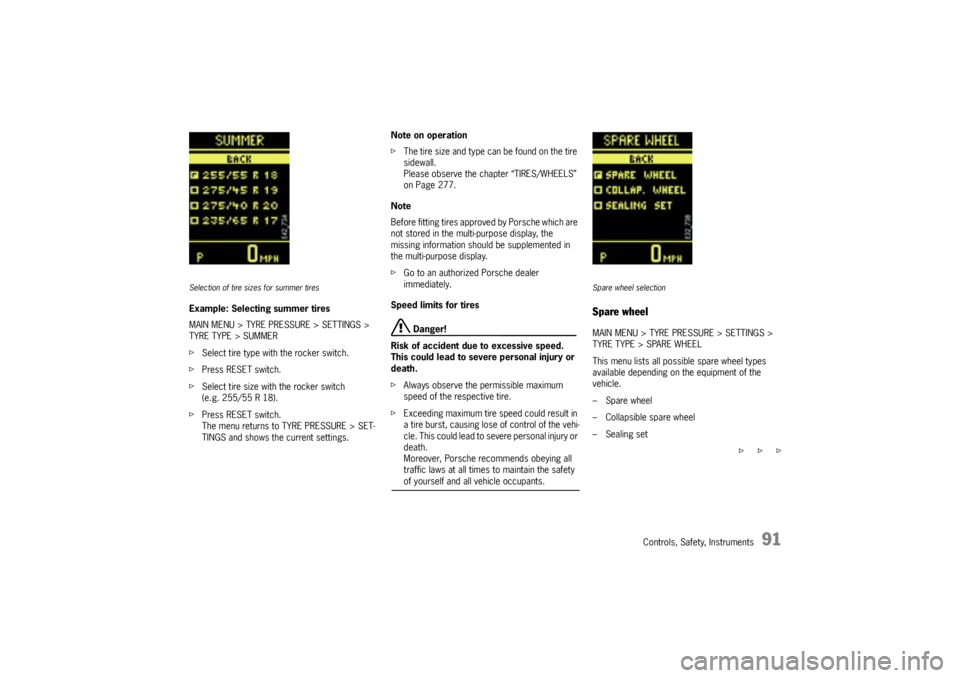
Controls, Safety, Instruments
91
Selection of tire sizes for summer tiresExample: Selecting summer tires
MAIN MENU > TYRE PRESSURE > SETTINGS >
TYRE TYPE > SUMMER
fSelect tire type with the rocker switch.
fPress RESET switch.
fSelect tire size with the rocker switch
(e.g. 255/55 R 18).
fPress RESET switch.
The menu returns to TYRE PRESSURE > SET-
TINGS and shows the current settings.Note on operation
fThe tire size and type can be found on the tire
sidewall.
Please observe the chapter “TIRES/WHEELS”
on Page 277.
Note
Before fitting tires approved by Porsche which are
not stored in the multi-purpose display, the
missing information should be supplemented in
the multi-purpose display.
fGo to an authorized Porsche dealer
immediately.
Speed limits for tires
Danger!
Risk of accident due to excessive speed.
This could lead to severe personal injury or
death.
fAlways observe the permissible maximum
speed of the respective tire.
fExceeding maximum tire speed could result in
a tire burst, causing lose of control of the vehi-
cle. This could lead to severe personal injury or
death.
Moreover, Porsche recommends obeying all
traffic laws at all times to maintain the safety of yourself and all vehicle occupants.
Spare wheel selectionSpare wheelMAIN MENU > TYRE PRESSURE > SETTINGS >
TYRE TYPE > SPARE WHEEL
This menu lists all possible spare wheel types
available depending on the equipment of the
vehicle.
–Spare wheel
– Collapsible spare wheel
– Sealing set
f f f
Page 92 of 380

92
Controls, Safety, Instruments Spare wheel Warning!
Risk of accident.
The spare wheel does not contain a wheel
transmitter and is not monitored by the tire
pressure monitoring system.
fThe spare wheel must be used only over short distances.
fPlease observe the chapter “SPARE WHEEL”
on Page 307.
fSelect SPARE WHEEL with the rocker switch.
fPress RESET switch.
The message SYSTEM NOT ACTIVE, WORK-
SHOP appears after the RESET switch is
pressed.
The display automatically returns to the TYRE
PRESSURE menu (filling information).
The required pressure specifications can be
read.
fSelect BACK. The menu returns to the basic
screen.
The reminder SPARE WHEEL OR SEALING SET OP-
ERATION appears each time the ignition is
switched on.
fPlease observe the chapter “” on Page 98.Collapsible spare wheel
Warning!
Risk of accident.
The spare wheel does not contain a wheel
transmitter and is not monitored by the tire
pressure monitoring system.
fThe collapsible spare wheel must be used only over short distances.
fPlease observe the chapter “COLLAPSIBLE
SPARE WHEEL” on Page 302.
fSelect COLLAPSIBLE WHEEL with the rocker
switch.
fPress RESET switch.
The required pressure and speed limit for the
collapsible spare wheel are displayed at first.
This is followed by the message SYSTEM NOT
ACTIVE, WORKSHOP.
A warning appears on the multi-purpose display if
the speed limit of 50 mph (80 km/h) is exceeded.
The reminder SPARE WHEEL OR SEALING SET OP-
ERATION appears each time the ignition is
switched on.
fPlease observe the chapter “” on Page 98.Tire sealant/sealing set
Warning!
Risk of accident.
fHave the tire replaced by a specialist work-
shop as soon as possible.
fAvoid hard acceleration and high cornering
speeds.
fDo not exceed maximum speed of 50 mph
(80 km/h).
fPlease observe the safety and operating in-structions on compressor.
fPlease observe the chapter “TIRE SEALANT”
on Page 296.
fSelect SEALING SET with the rocker switch.
fPress RESET switch.
The display automatically returns to the
TYRE PRESSURE menu (filling information).
fInflate tires according to the displayed
pressure differences.
A warning appears on the multi-purpose display if
the speed limit of 50 mph (80 km/h) is exceeded.
SPARE WHEEL OR SEALING SET OPERATION ap-
pears each time the ignition is switched on.
fPlease observe the chapter “” on Page 98.
Page 93 of 380
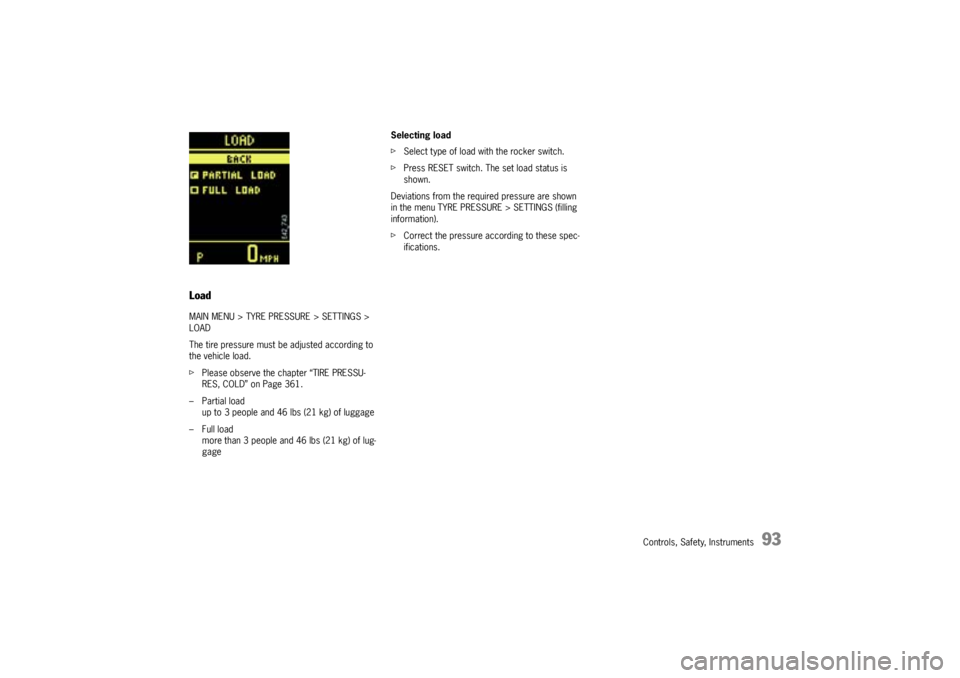
Controls, Safety, Instruments
93
LoadMAIN MENU > TYRE PRESSURE > SETTINGS >
LOAD
The tire pressure must be adjusted according to
the vehicle load.
fPlease observe the chapter “TIRE PRESSU-
RES, COLD” on Page 361.
– Partial load
up to 3 people and 46 lbs (21 kg) of luggage
– Full load
more than 3 people and 46 lbs (21 kg) of lug-
gageSelecting load
fSelect type of load with the rocker switch.
fPress RESET switch. The set load status is
shown.
Deviations from the required pressure are shown
in the menu TYRE PRESSURE > SETTINGS (filling
information).
fCorrect the pressure according to these spec-
ifications.
Page 94 of 380
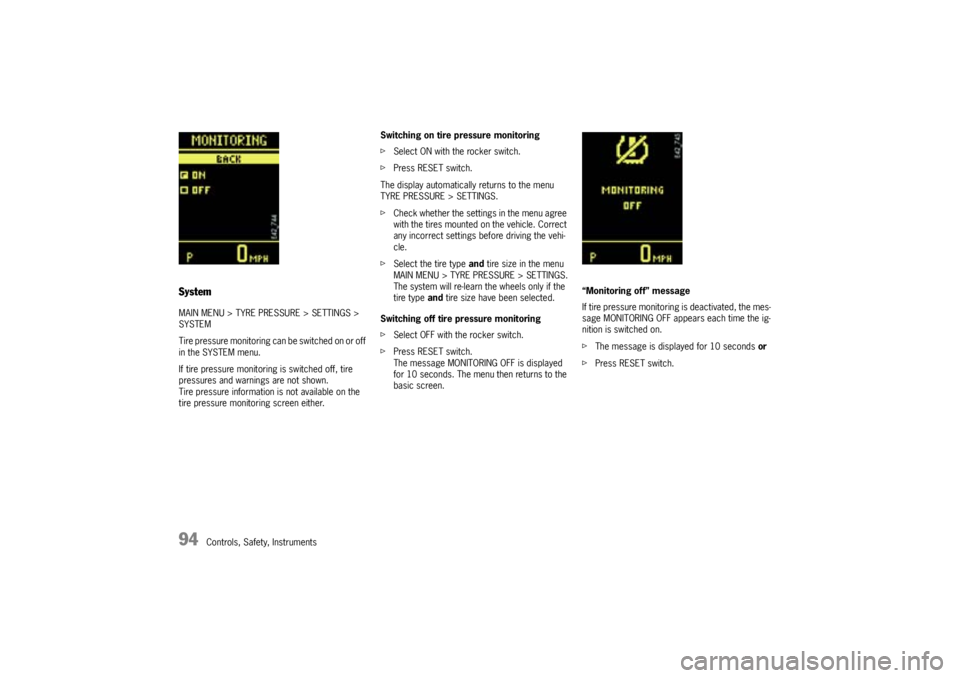
94
Controls, Safety, Instruments
SystemMAIN MENU > TYRE PRESSURE > SETTINGS >
SYSTEM
Tire pressure monitoring can be switched on or off
in the SYSTEM menu.
If tire pressure monitoring is switched off, tire
pressures and warnings are not shown.
Tire pressure information is not available on the
tire pressure monitoring screen either.Switching on tire pressure monitoring
fSelect ON with the rocker switch.
fPress RESET switch.
The display automatically returns to the menu
TYRE PRESSURE > SETTINGS.
fCheck whether the settings in the menu agree
with the tires mounted on the vehicle. Correct
any incorrect settings before driving the vehi-
cle.
fSelect the tire type and tire size in the menu
MAIN MENU > TYRE PRESSURE > SETTINGS.
The system will re-learn the wheels only if the
tire type and tire size have been selected.
Switching off tire pressure monitoring
fSelect OFF with the rocker switch.
fPress RESET switch.
The message MONITORING OFF is displayed
for 10 seconds. The menu then returns to the
basic screen.“Monitoring off” message
If tire pressure monitoring is deactivated, the mes-
sage MONITORING OFF appears each time the ig-
nition is switched on.
fThe message is displayed for 10 seconds or
fPress RESET switch.
Page 95 of 380
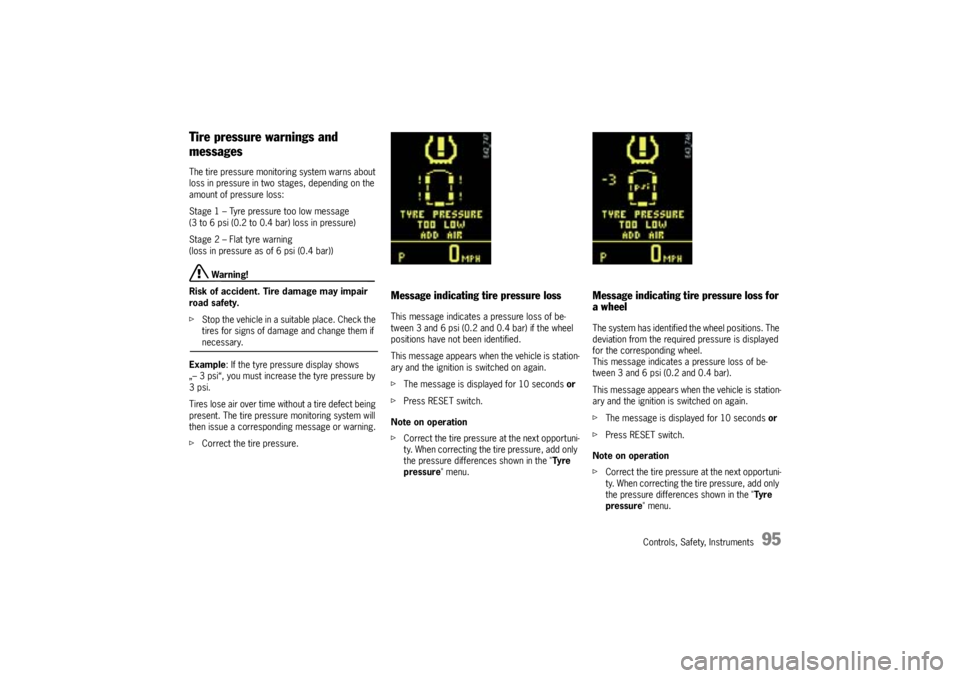
Controls, Safety, Instruments
95
Tire pressure warnings and
messagesThe tire pressure monitoring system warns about
loss in pressure in two stages, depending on the
amount of pressure loss:
Stage 1 – Tyre pressure too low message
(3 to 6 psi (0.2 to 0.4 bar) loss in pressure)
Stage 2 – Flat tyre warning
(loss in pressure as of 6 psi (0.4 bar))
Warning!
Risk of accident. Tire damage may impair
road safety.
fStop the vehicle in a suitable place. Check the
tires for signs of damage and change them if necessary.
Example: If the tyre pressure display shows
„– 3 psi“, you must increase the tyre pressure by
3psi.
Tires lose air over time without a tire defect being
present. The tire pressure monitoring system will
then issue a corresponding message or warning.
fCorrect the tire pressure.
Message indicating tire pressure lossThis message indicates a pressure loss of be-
tween 3 and 6 psi (0.2 and 0.4 bar) if the wheel
positions have not been identified.
This message appears when the vehicle is station-
ary and the ignition is switched on again.
fThe message is displayed for 10 seconds or
fPress RESET switch.
Note on operation
fCorrect the tire pressure at the next opportuni-
ty. When correcting the tire pressure, add only
the pressure differences shown in the "Ty re
pressure" menu.
Message indicating tire pressure loss for
a wheelThe system has identified the wheel positions. The
deviation from the required pressure is displayed
for the corresponding wheel.
This message indicates a pressure loss of be-
tween 3 and 6 psi (0.2 and 0.4 bar).
This message appears when the vehicle is station-
ary and the ignition is switched on again.
fThe message is displayed for 10 seconds or
fPress RESET switch.
Note on operation
fCorrect the tire pressure at the next opportuni-
ty. When correcting the tire pressure, add only
the pressure differences shown in the "Ty re
pressure" menu.
Page 96 of 380
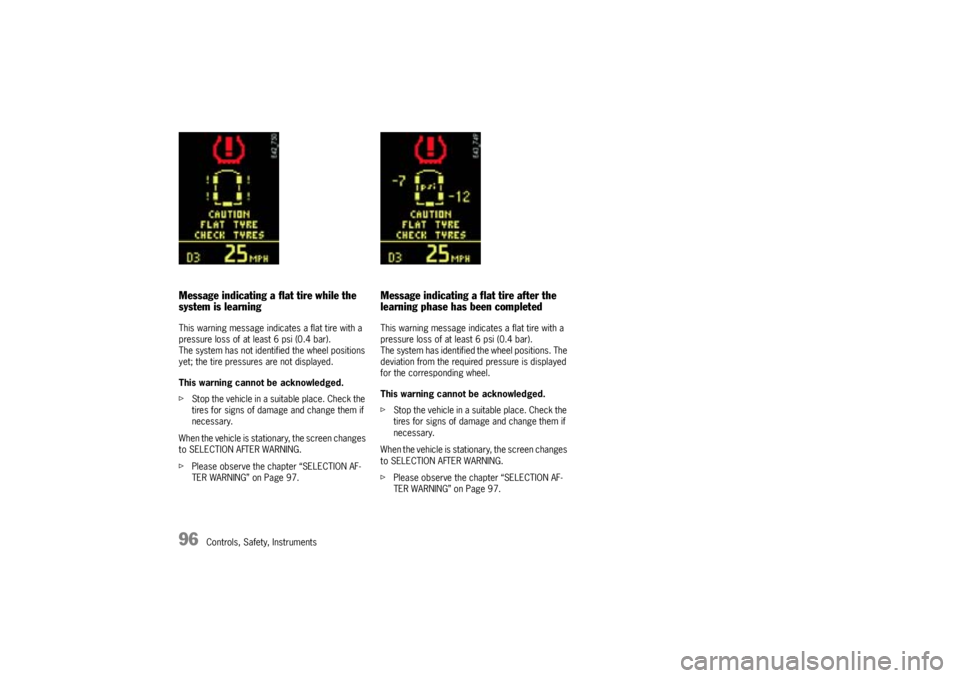
96
Controls, Safety, Instruments
Message indicating a flat tire while the
system is learningThis warning message indicates a flat tire with a
pressure loss of at least 6 psi (0.4 bar).
The system has not identified the wheel positions
yet; the tire pressures are not displayed.
This warning cannot be acknowledged.
fStop the vehicle in a suitable place. Check the
tires for signs of damage and change them if
necessary.
When the vehicle is stationary, the screen changes
to SELECTION AFTER WARNING.
fPlease observe the chapter “SELECTION AF-
TER WARNING” on Page 97.
Message indicating a flat tire after the
learning phase has been completedThis warning message indicates a flat tire with a
pressure loss of at least 6 psi (0.4 bar).
The system has identified the wheel positions. The
deviation from the required pressure is displayed
for the corresponding wheel.
This warning cannot be acknowledged.
fStop the vehicle in a suitable place. Check the
tires for signs of damage and change them if
necessary.
When the vehicle is stationary, the screen changes
to SELECTION AFTER WARNING.
fPlease observe the chapter “SELECTION AF-
TER WARNING” on Page 97.
Page 97 of 380
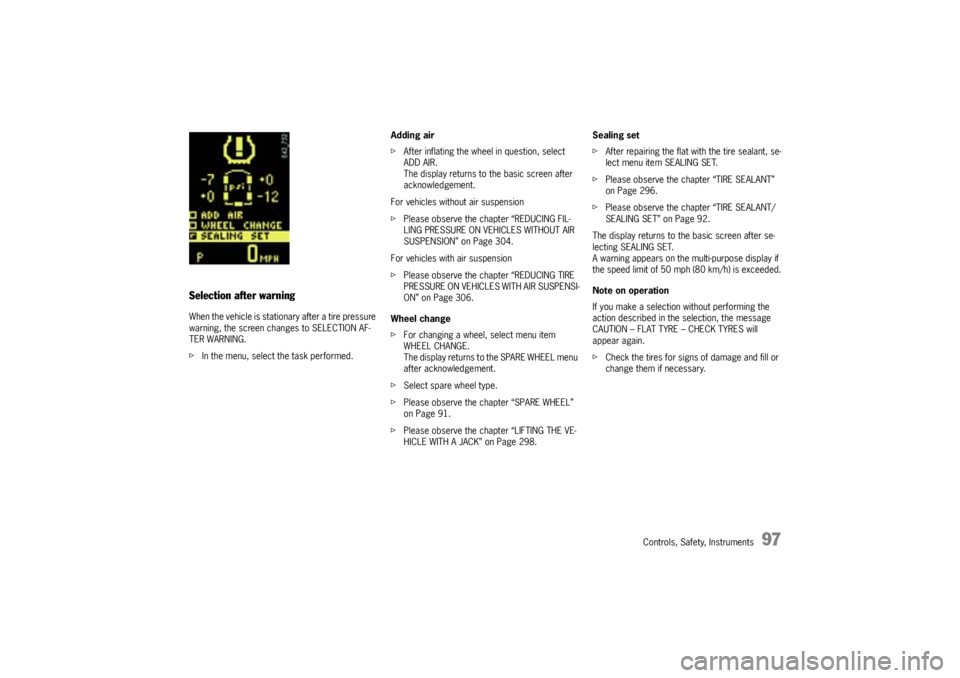
Controls, Safety, Instruments
97
Selection after warningWhen the vehicle is stationary after a tire pressure
warning, the screen changes to SELECTION AF-
TER WARNING.
fIn the menu, select the task performed.Adding air
fAfter inflating the wheel in question, select
ADD AIR.
The display returns to the basic screen after
acknowledgement.
For vehicles without air suspension
fPlease observe the chapter “REDUCING FIL-
LING PRESSURE ON VEHICLES WITHOUT AIR
SUSPENSION” on Page 304.
For vehicles with air suspension
fPlease observe the chapter “REDUCING TIRE
PRESSURE ON VEHICLES WITH AIR SUSPENSI-
ON” on Page 306.
Wheel change
fFor changing a wheel, select menu item
WHEEL CHANGE.
The display returns to the SPARE WHEEL menu
after acknowledgement.
fSelect spare wheel type.
fPlease observe the chapter “SPARE WHEEL”
on Page 91.
fPlease observe the chapter “LIFTING THE VE-
HICLE WITH A JACK” on Page 298.Sealing set
fAfter repairing the flat with the tire sealant, se-
lect menu item SEALING SET.
fPlease observe the chapter “TIRE SEALANT”
on Page 296.
fPlease observe the chapter “TIRE SEALANT/
SEALING SET” on Page 92.
The display returns to the basic screen after se-
lecting SEALING SET.
A warning appears on the multi-purpose display if
the speed limit of 50 mph (80 km/h) is exceeded.
Note on operation
If you make a selection without performing the
action described in the selection, the message
CAUTION – FLAT TYRE – CHECK TYRES will
appear again.
fCheck the tires for signs of damage and fill or
change them if necessary.
Page 98 of 380
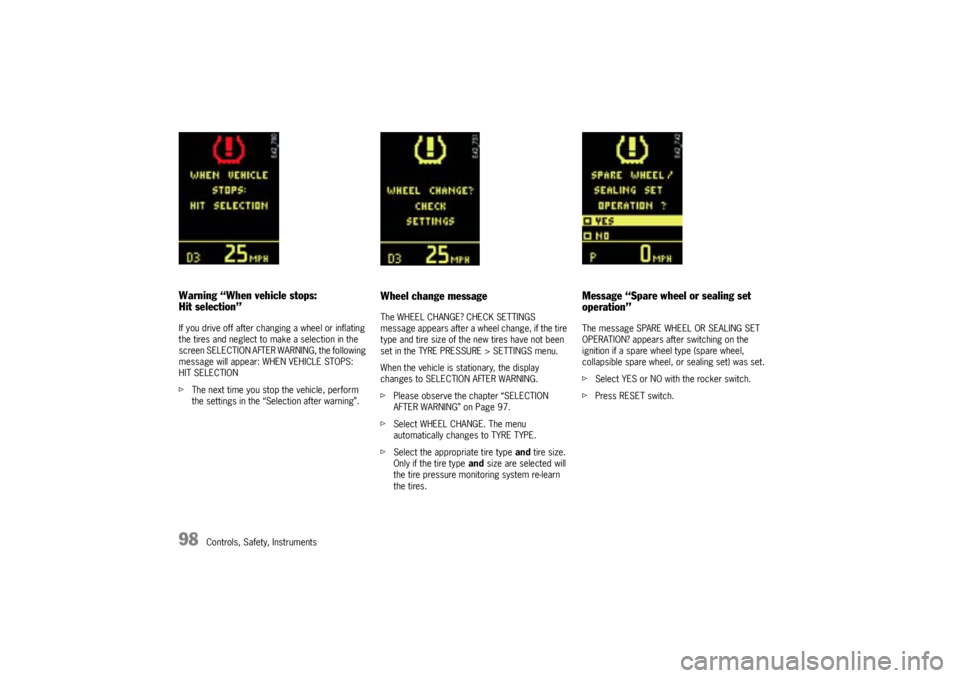
98
Controls, Safety, Instruments
Warning “When vehicle stops:
Hit selection”If you drive off after changing a wheel or inflating
the tires and neglect to make a selection in the
screen SELECTION AFTER WARNING, the following
message will appear: WHEN VEHICLE STOPS:
HIT SELECTION
fThe next time you stop the vehicle, perform
the settings in the “Selection after warning”.
Wheel change messageThe WHEEL CHANGE? CHECK SETTINGS
message appears after a wheel change, if the tire
type and tire size of the new tires have not been
set in the TYRE PRESSURE > SETTINGS menu.
When the vehicle is stationary, the display
changes to SELECTION AFTER WARNING.
fPlease observe the chapter “SELECTION
AFTER WARNING” on Page 97.
fSelect WHEEL CHANGE. The menu
automatically changes to TYRE TYPE.
fSelect the appropriate tire type and tire size.
Only if the tire type and size are selected will
the tire pressure monitoring system re-learn
the tires.
Message “Spare wheel or sealing set
operation”The message SPARE WHEEL OR SEALING SET
OPERATION? appears after switching on the
ignition if a spare wheel type (spare wheel,
collapsible spare wheel, or sealing set) was set.
fSelect YES or NO with the rocker switch.
fPress RESET switch.
Page 99 of 380

Controls, Safety, Instruments
99
Ye s :
– In case of sealing-set operation, the menu
changes directly to the basic screen. All
settings are retained.
– If the vehicle is operated with a collapsible
spare wheel or spare wheel, the warning mes-
sage “SYSTEM NOT ACTIVE, WORKSHOP” is
initially displayed for 10 seconds. The system
then returns to the basic screen.
No:
The display automatically returns to the menu
TYRE PRESSURE > SETTINGS.
fSet the mounted tire set with tire type and tire
size. The system will re-learn the tires.
No monitoringIn the event of faults the tire pressure monitoring
cannot monitor the tire pressure.
The warning light on the instrument panel and a
message on the multi-purpose display light up.
Monitoring is not active when:
– the tire pressure monitoring system is faulty,
– wheel transmitters for the tire pressure
monitoring system are not present,
– temporarily after changing a wheel,
– has detected too many wheel transmitters,
– there is external interference by other radio
sources, e.g., wireless headphones,
– tire temperatures are too high.
fPlease observe the chapter “WARNING LIGHTS
AND WARNING MESSAGES” on Page 108.fAll warnings and messages in the tire pressure
monitoring system are also indicated by the
warning light in the instrument panel.
The warning light goes out as soon as all faults
are remedied.
Tire pressure monitoring system
warning light
Page 100 of 380
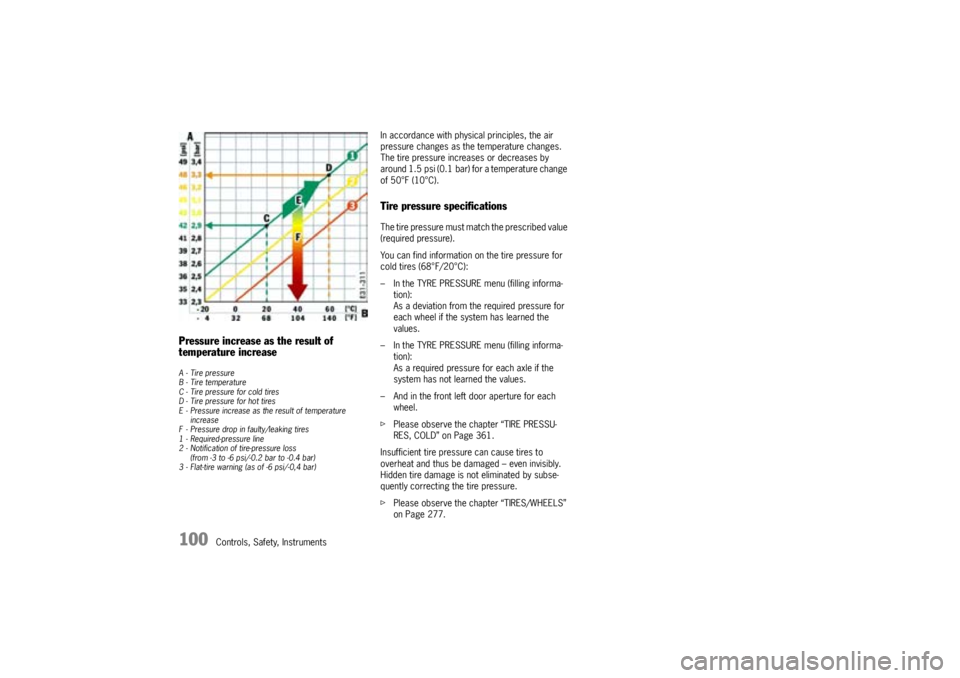
100
Controls, Safety, Instruments
Pressure increase as the result of
temperature increaseA - Tire pressure
B - Tire temperature
C - Tire pressure for cold tires
D - Tire pressure for hot tires
E - Pressure increase as the result of temperature
increase
F - Pressure drop in faulty/leaking tires
1 - Required-pressure line
2 - Notification of tire-pressure loss
(from -3 to -6 psi/-0.2 bar to -0.4 bar)
3 - Flat-tire warning (as of -6 psi/-0,4 bar)
In accordance with physical principles, the air
pressure changes as the temperature changes.
The tire pressure increases or decreases by
around 1.5 psi (0.1 bar) for a temperature change
of 50°F (10°C).Tire pressure specificationsThe tire pressure must match the prescribed value
(required pressure).
You can find information on the tire pressure for
cold tires (68°F/20°C):
– In the TYRE PRESSURE menu (filling informa-
tion):
As a deviation from the required pressure for
each wheel if the system has learned the
values.
– In the TYRE PRESSURE menu (filling informa-
tion):
As a required pressure for each axle if the
system has not learned the values.
– And in the front left door aperture for each
wheel.
fPlease observe the chapter “TIRE PRESSU-
RES, COLD” on Page 361.
Insufficient tire pressure can cause tires to
overheat and thus be damaged – even invisibly.
Hidden tire damage is not eliminated by subse-
quently correcting the tire pressure.
fPlease observe the chapter “TIRES/WHEELS”
on Page 277.